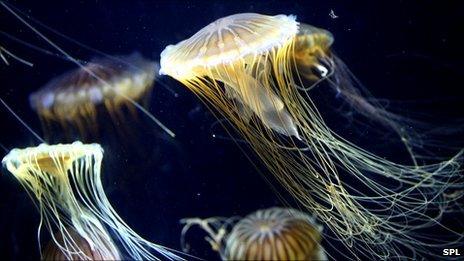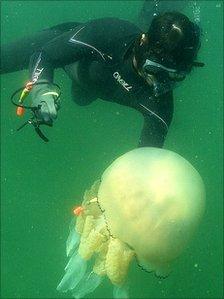Who, What, Why: Why are we plagued by jellyfish?
- Published

Jellyfish numbers appear to be on the rise in UK waters, research suggests. So why is the sea turning into "jellyfish soup"?
Britain's beaches are increasingly facing some unusual visitors, with research suggesting jellyfish numbers are on the increase in UK waters.
It's not only beach-goers who have to watch out. Torness nuclear power plant in Scotland recently had to shut down after moon jellyfish blocked the water intake system. Several tonnes of the creatures had to be cleared out.
Some areas, including the Irish Sea and the east coast of Scotland, have been invaded by so many they now resemble a "jellyfish soup", says the Marine Conservation Society (MCS). So why do they appear to be on the increase?
According to research there is strong evidence that an increase is linked to three main factors - pollution, overfishing and possibly climate change.
Pollution such as sewage and fertilisers run off the land and into the sea, causing increased nutrients in the water. This can boost jellyfish numbers as the nutrients increase plankton which they feed on, along with fish.
Overfishing means jellyfish do not face their usual predators and competitors, which usually regulate population growth. Large fish, which eat jellyfish, have been drastically reduced by bad fishing practices, says Ocean 2012, a pressure group which campaigns to stop overfishing. So have smaller fish which compete for food with the stingers.
It is argued that climate change can cause more favourable conditions for jellyfish, with their adaptability giving them an advantage over some other sea creatures.
Huge blooms
It is difficult to estimate the jellyfish population in UK waters because very little research has been done and in the past they were ignored in long-term fishing surveys, says Dr Victoria Hobson, from EcoJel, a project researching the distribution and abundance of jellyfish. Its current study has been running since 2008.

Researchers are tagging jellyfish to follow their movements
"This also makes it difficult to get a handle on how numbers have changed," she says. "Even in recent years people are doing a lot more watersports so are spotting more.
"With the development of smartphones it is also much easier to report those sightings. It makes it difficult to interpret if there are actually more jellyfish or just more sightings."
The MCS has been running a national jellyfish survey since 2003, where the public report sightings. Dr Richardson agrees it's probably too early to draw any firm conclusions from the data, but says a few other organisations have been doing systematic at-seas surveys over recent decades and they have shown a rise in jellyfish numbers in UK waters.
"Our survey reflects that," he says. "Some of the people who have been reporting jellyfish to us say they have lived by the coast for years and never seen anything like it.
"This year we received our first reports of the huge but harmless barrel jellyfish off north Wales back in early January. This species has occurred in huge numbers in the Irish Sea and beyond ever since, with reports received from north Somerset to the Firth of Clyde."
There are hundreds of types of jellyfish, with a few common species in the UK. These include the moon jellyfish, which can grow to the size of a saucer, and the barrel jellyfish, which can get as big as a large household dustbin. Some do sting, but in most cases it causes just a mild rash. The occasional Portuguese man o'war has been spotted in UK waters and its sting is far more serious.
Economic impact
A group of jellyfish is called a "bloom". Scientists say it is difficult to measure blooms because of the sheer numbers involved and the fact jellyfish spend time at depth, as well as on the surface. But a bloom of barrel jellyfish can cover an area the size of Carmarthen Bay in Wales and numbers can run into hundreds of thousands, says Dr Hobson.
EcoJel's project involves tagging jellyfish to study their movements. Monitoring jellyfish numbers is important because they are an indication of the state of oceans. If they overtake fish and start to dominate an area - as they have off the coast of Namibia - this causes environmental and economic problems, says Dr Hobson.
In 2007 a jellyfish invasion wiped out Northern Ireland's only salmon farm, killing more than 100,000 fish. At the time a spokesman said the attack could cost the company more than £1m. They can also have an impact on tourism. In 2008 the Red Cross treated 400 people for jellyfish stings in a single day on a beach in Malaga, Spain.
But one consequence to come from the growing numbers is increased sightings of leatherback sea turtles, which feed on them, in UK waters. Dr Richards says there has been an unusually high number of sighting in 2011 - six in six days recently.
"That's an amazing number, it's definitely a good year for turtles."